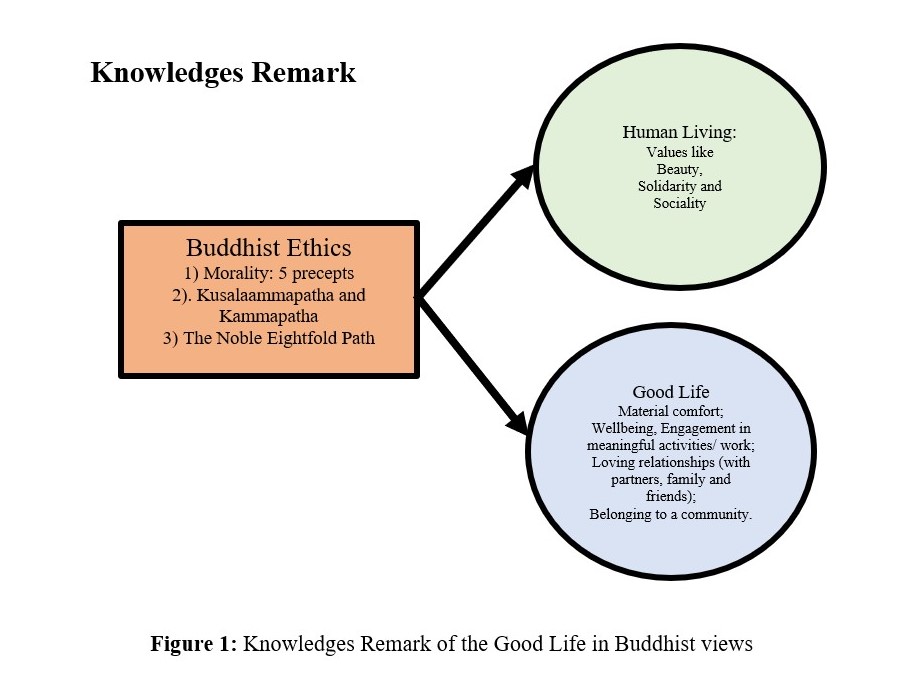Human Living and a Good Life Based on Buddhist Ethics
Main Article Content
Abstract
The study of Buddhist ethics and the good life of human beings found that the good life of human beings according to the principle of action "what is good" or "what is not good", "what should" or “what should not”. The criteria to judge the good we have to follow are: 5 precepts, the tenfold way of good action and the noble eightfold path, these three are ethical judgments to give people a good life and live together as a society as well and happy to have moral ethics. (1) The moral of human life is basic. This is a basic morality. (2) Moral in the middle of human life to raise the morality of ethics. (3) Moral of advanced human life. This is the moral of the three virtues, which is the life of human beings in Buddhism. Ethics is based on two actions are classified as: (1) Any action based on merit is considered good deeds are useful. And (2) actions based on genitals are considered evil acts. There is a great deal to judge what is wrong, what is worth, what is not worth. The main consideration is the intent of action. The Buddhist scriptures Mental behavior Effects of action and the results of the practice. In Buddhist ethics, it must be implemented and prove to be true self. It will be called knowing the rules of good judgment and it works really well without anyone to cheat on it.
Article Details
References
Bunmee Thaenkaew. (1984). Philosophy of the Eastern Region. Bangkok:
Department of Philosophy and Religion Faculty of Humanities and Social Sciences, Bansomdejchaopraya Teachers College.
______.(1997). Buddhism and philosophy. (Buddhism and Philosophy).
Bangkok: W. Petcharakul Company Limited.
Phradhammapidok (P.A. Payutto). (1997). Dictionary of Buddhism. Glossary
edition. 8th printing, celebrating the Tipitaka in Pali language, Lanna script. Bangkok: Mahachulalongkornrajavidyalaya University.
______. (2003). Buddhadhamma, revised and expanded edition. 11th printing.
Bangkok: Mahachulalongkornrajavidyalaya Printing House.
Phrathepvethi (P.A. Payutto). (1989). Revised and expanded edition of
Buddhadhamma. Bangkok: Mahachulalongkornrajavidyalaya.
______. (1993). The more one steps towards happiness, the closer one gets to
Dhamma. Bangkok: Thammasabha.
Phrarajvaramuni (Prayura Dhammajitto). (1982). Buddhadhamma, revised and
expanded edition. 6th printing. Bangkok: Dhammasathan Chulalongkorn University.
Mahachulalongkornrajavidyalaya University. (1992). Pali Tripitaka. Mahachula
Tepiṭaka edition. 1957. Bangkok: Mahachulalongkornrajavidyalaya Printing House.
______. (1996). Thai Tripitaka. Mahachulalongkornrajavidyalaya edition.
Bangkok: Mahachulalongkornrajavidyalaya Printing House.
Siwarak. S. (1983). The first step of Western philosophy. Bangkok: Thai
Wiwattana Panich Publishing Company Limited.
Somphan Promtha. (1992). Buddhism and ethical problems. Bangkok:
Saramuan Chon Company Limited.
Wit Wisthawet. (1983). Basic ethics: Humans and ethical problems. 4th
printing. Bangkok: Aksorn Charoenthat.
Wasin Inthasara. (2006). Buddhist ethics. 2nd printing. Bangkok: Thammada
Publishing House.
Royal Academy. (1989). English-Thai Philosophical Dictionary. Bangkok:
Amarin Printing Group.
Aristotle, (1925). Nicomachean Ethics. First published by Oxford New York.
Oxford University Press.
Stumpf, Samuel Enoch. (1975). Socrates to Sartre: a History of Philosophy.
nd ed. Royal Institute Dictionary, Royal Institute Edition 1999. Bangkok: Printed at Nanmee Book Publishing, 1999.


